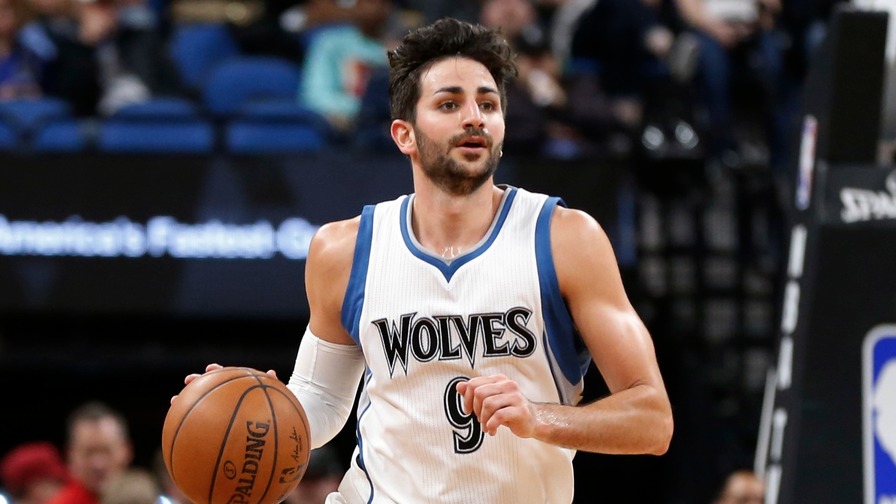What Should We Make of Ricky Rubio's Recent Surge?

It was only a little over a month ago that the Minnesota Timberwolves were actively planning to trade point guard Ricky Rubio to the New York Knicks for Derrick Rose as a way to continue their rebuild.
At the last minute, the Timberwolves decided they would be better off keeping Rubio, and since then, he has rewarded them for their decision to keep him.
In the 17 games since the All-Star break, Rubio has increased his stats all across the board, culminating with his scoring a career-high 33 points Thursday night against the Los Angeles Lakers. Rubio's increase in production has had an impact on the Timberwolves' overall performance, as the team has won 47.1% of their games post-All Star break as opposed to the 38.6% of games that they won before the break.
Additionally, Rubio has gone from having a negative net rating of -2.3 to a positive net rating of 2.9 when on the court.
What Has Sparked This Offensive Explosion?
For most of his career, Rubio has been typecast as a passing savant who was unable and unwilling to shoot.
Since the All-Star break, Rubio has been more assertive on the offensive end in terms of searching for his own shot, and it has been noticeable.
In just two more minutes of action per game, Rubio has increased his scoring output by almost eight points, while attempting five more shots per game. In addition to shooting more, Rubio's getting to the free throw line more frequently than he did earlier in the season.
| Rubio Splits | Min | Pts | Reb | Ast | Ast% | FG% | FGA | 3P% | FT% | FTA | TS% | USG% |
|---|---|---|---|---|---|---|---|---|---|---|---|---|
| Pre-Break | 32.1 | 8.9 | 3.8 | 8.4 | 36.0 | 38.6 | 7.0 | 28.1 | 87.2 | 3.2 | 53.0 | 15.1 |
| Post-Break | 34.2 | 16.8 | 4.5 | 10.5 | 45.9 | 46.3 | 12.1 | 43.8 | 91.4 | 4.8 | 59.2 | 22.5 |
The assertiveness has manifested itself most noticeably in Rubio's usage rate. This has coincided with the loss of guard Zach LaVine for the season with a torn ACL, who used about 22% of Minnesota's possessions when he was on the court.
Rubio has admirably filled that void, increasing his assist rate from 36% to 46% when on the floor. He has also increased his percentage of shots taken from 12.5% to 19.9%. The Timberwolves have also actually posted a higher offensive rating (109.1 to 107.7) since Rubio has made himself a larger focus of the Timberwolves' offense.
All of Rubio's shooting stats have skyrocketed since the All-Star break.
The 59.2% true shooting percentage that he has in this streak is higher than his career-best season (52.9%) and 8.8 percentage points better than his career average (50.4%). He's also posting career highs in field goal percentage, three-point percentage, and free throw percentage, which has contributed to the spike in his production.
His improvement from the three-point arc has been the most significant because Rubio hasn't increased his three-point attempts per game but has become significantly more efficient from long range. That efficiency can be traced to the fact that he's converting more above-the-break three-pointers.
Throughout his career, Rubio has been a decent shooter from the corners but struggled when it came to shooting above-the-break threes, which has accounted for most of his career attempts. Rubio has shot 42.5% on above-the-break threes in this 17-game period, as opposed to the 30% that he shot on those shots before the All-Star game.
Is This Sustainable?
Rubio is currently posting his highest usage rate in a month (22.6%) since April 2013. In that month, Rubio attempted 11.2 shots per game but did not come close to matching the shooting stats that he's currently producing.
If you were to extrapolate Rubio's post-All Star stats for a full season, the only players to match this production for a full season are John Stockton (twice), Chris Paul (twice), and Steve Nash (six times). Ironically enough, if you were curious to see what a full season of Rubio's play would look like, you could look no further than Chris Paul, who has performed on a similar level for this whole season.
It's unlikely that Rubio would be able to continue playing at this level for a full season, but there's enough data that shows that, whenever he's looking to score, his team benefits from that aggressiveness.
What's Next?
The Timberwolves will have an interesting decision to make this summer.
They drafted Kris Dunn fifth in the 2016 NBA Draft with the intention of having him become their point guard of the future alongside Karl-Anthony Towns, Andrew Wiggins, and LaVine.
Given that Rubio is four years older than the Timberwolves' core, it might make sense to move him to a more experienced team that could utilize his skill set. They also would be moving a player whose trade value might never be higher after this period of stellar play.
However, if they decide to keep him on the roster, there's evidence of how the team could thrive with him taking a more assertive scoring role.
















